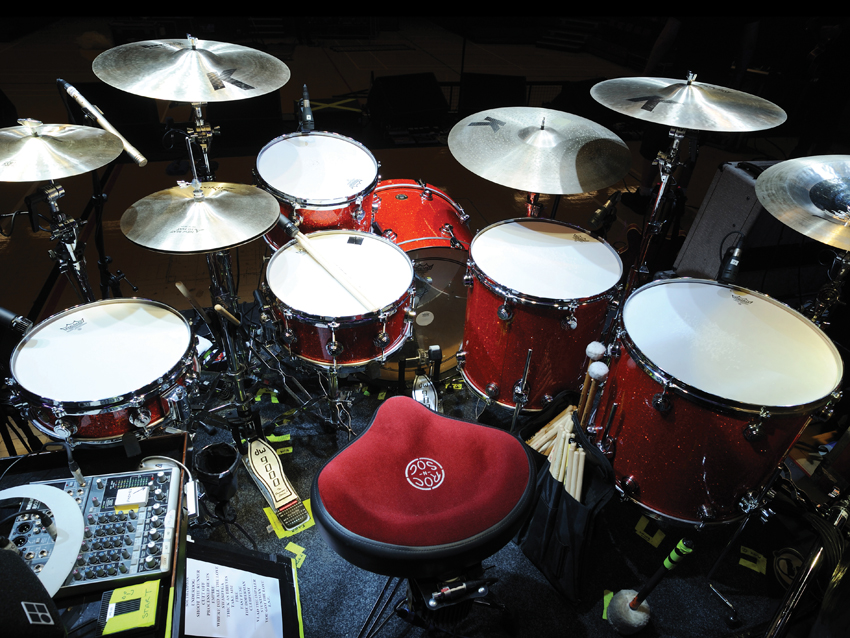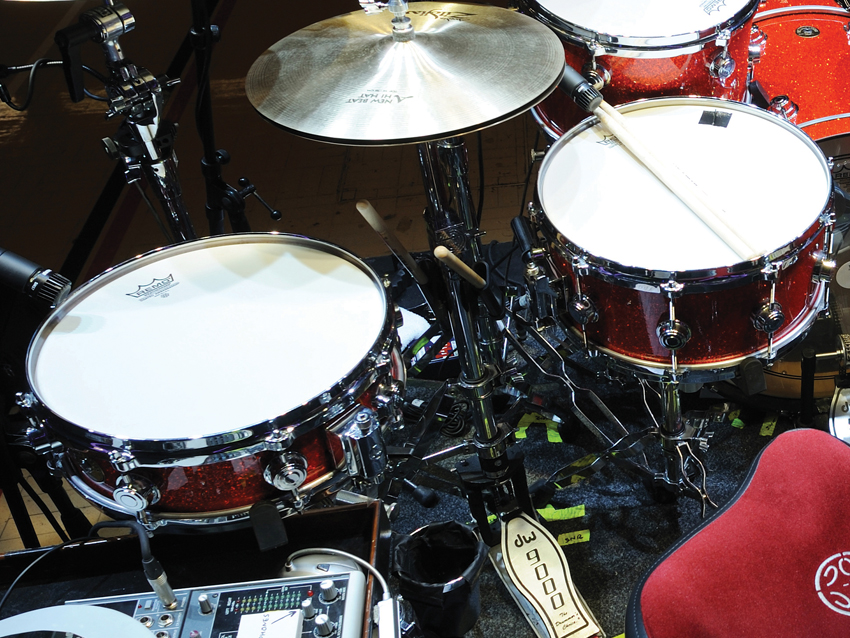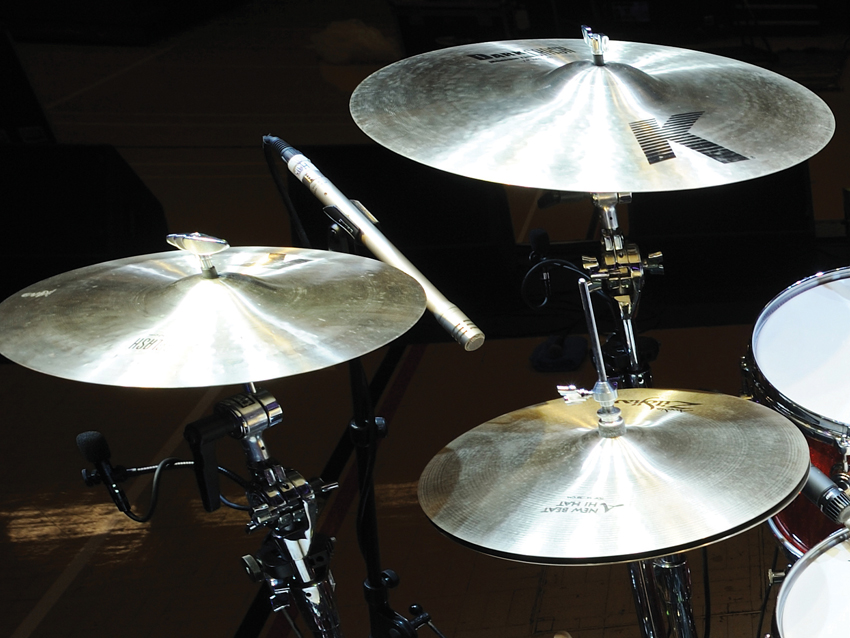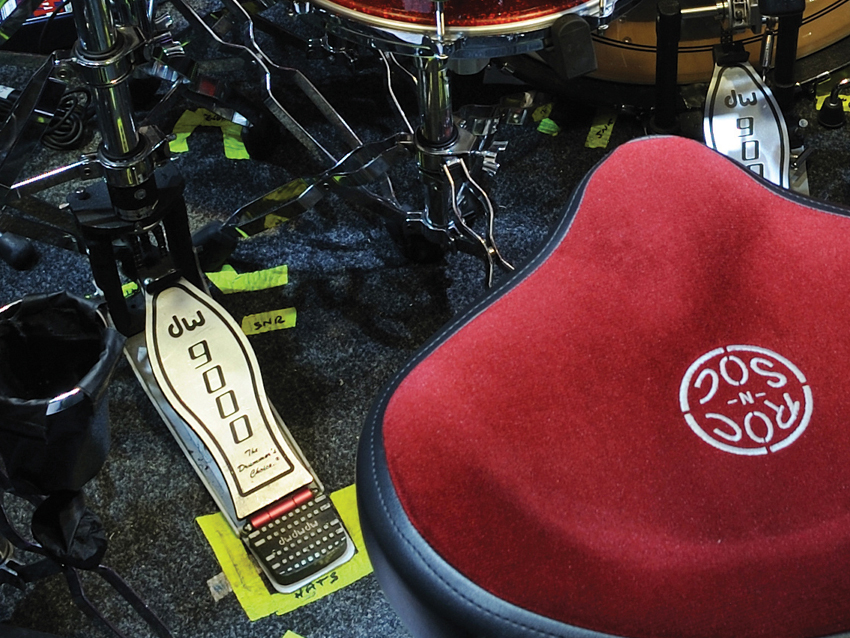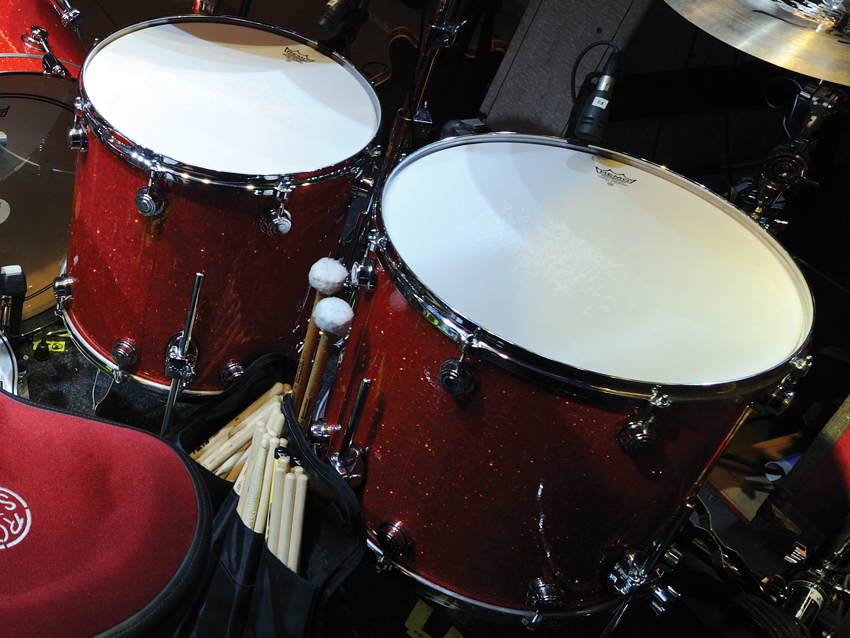Kasabian's drum setup in pictures
A look at the kit behind new album Velociraptor!
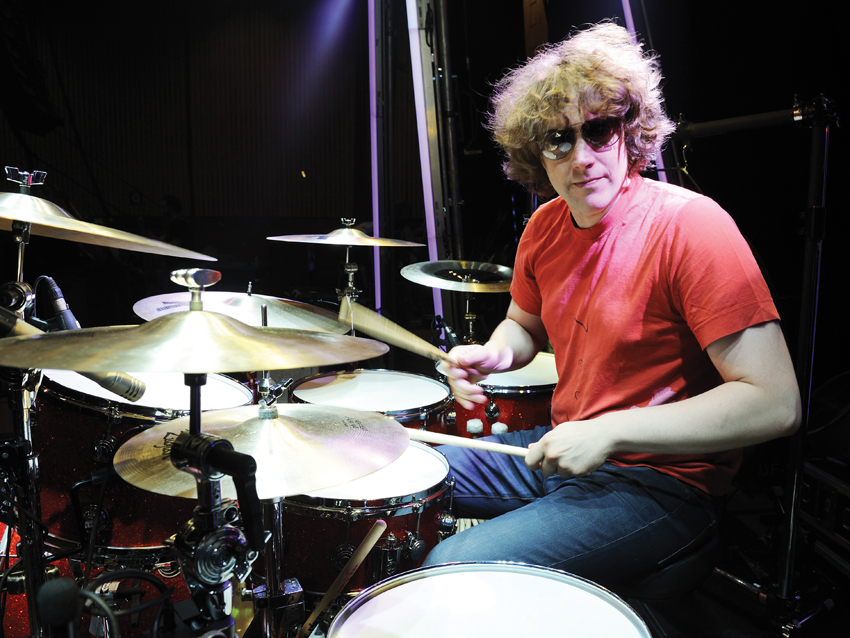
Ian Matthews' drum setup in pictures
Appropriately for a record named after an institution for the insane, Kasabian’s third album West Ryder Pauper Lunatic Asylum displays the full symptoms of the multiple personality disorder that comes from the head-on collision of rock’n’roll and electronic dance music. It has the anthemic choruses of rock, powered by beats that sound equal parts machine and man.
The human part of the equation comes from Ian Matthews, a drummer who grew up behind the kit, playing with his dad’s band and spending his teens working in jazz bands and orchestra pits in the theatres of Bristol.
On the eve of the band’s fourth LP Velociraptor! (due for release in September 2011), we’re revisiting Rhythm’s interview with Ian Matthews about the West Ryder recording process, Kasabian’s hip-hop connection, and to take a closer look at Ian’s DW drum setup...
- Find your next setup with our guide to the best drum kits
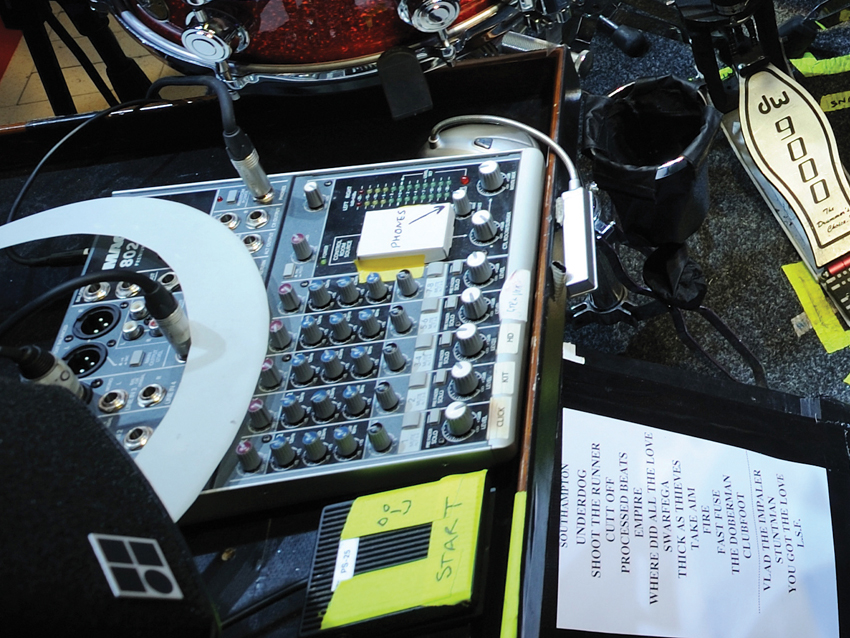
Real drums vs processed beats
The drums on the new album sound like drum machines, more so than they did on Empire. Was that the sound you were after from the outset?
"Kasabian come from a processed beats background as well as loving rock’n’roll bands such as The Beatles, the ’Stones, The Who and Oasis. There’s another side to this band, particularly for Serge. He loves DJ Shadow. Tom has an enormous hip-hop influence.
"Hip-hop was a big part of the growing up process of the musicians in the band. There has always been this marrying of rock’n’roll and the sampled beat. With Empire we went a little more rock’n’roll, but there are tunes on there like Stuntman which are much more sampled.
"On Shoot The Runner my drums were layered upon themselves to create a drum section as opposed to a drum kit being played. Coming into West Ryder we wanted to go back to the more processed sound but still keep that rock’n’roll element."

Recording drums
So tell us how you went about recording your drum parts?
"We’ve got a little studio in Leicester and that’s where 90 percent of this album was recorded, particularly the drumming. I used a combination of my DW drums, some key vintage kits, bass drums and snares and stuff to create the various patterns. Each track has got a different vibe. Some tracks needed a massive drum sound, some needed a little jazz kit.
"There is a lot of drum percussion; I’m almost recreating an orchestral percussion section with drums and shaky things. It’s not necessarily playing drum kits with two overheads and mics on the toms and the snare. I may be playing a bass drum with timpani sticks, or wrapping a bass drum pedal in loads of j-cloths and I’m hitting it like an orchestral bass drum.
"There’s one track where I played the whole drum kit just with my hands, playing a soft ballroom rumba. There’s a lot going on, it’s not just me playing a drum kit in a room for 12 tunes. We wanted to get away from that. That’s the recording side.
"Then we took the entire lot to Dan The Automator in San Francisco. This guy has a massive hip-hop heritage, he’s pedigree. This is where the real mapping started, combining my drumming with the samples underneath. It brings it in, it’s surprising how simple yet how effective it is just taking a normal rhythm and putting the machine underneath it.
"It closes the whole thing in and your ear winds up hearing it as being more automated than it is."
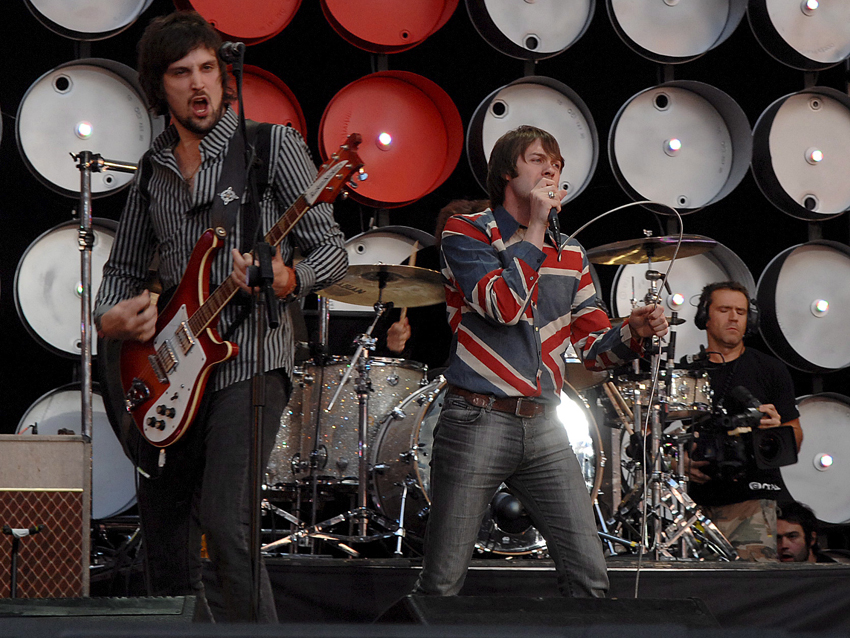
Hip-hop, jazz and theatrical drumming
How much does your background in jazz and playing theatrical gigs impact on how you approach the music in Kasabian?
"Massively, in fact I think this is why I slotted straight in with Kasabian, because the boys have got such a wide influential scope. These boys have been listening to hip-hop since they were kids.
"The hip-hop genre itself is an amalgamation of funk and jazz, samples are taken from classic Blue Note and Motown records. To be an effective hip-hop drummer you are going to have to have the touch and the feel and the independence that comes with training in, listening to and playing jazz and soul.
"The theatrical stuff was so important with my head being bent left and right over the years since I was a kid, playing in rock bands, playing the backbeat, playing jazz and big band music. All these styles have gone into my head and made it easier for me to be able to play with Kasabian.
"Kasabian has much more than just two and four going on. There are tunes on West Ryder that are blatantly very orchestral-feeling, almost like a pit drummer. I grew up playing social clubs with my dad who was an organist. I’ve taken something from those days and plonked it straight in the middle of a modern, 21st Century, futuristic, psychedelic rock’n’roll album.
"I feel very lucky that I’ve had those experiences."

In the studio
So what sort of environment did you use for the drum recordings in Leicester?
"The studio is in an old shoe factory. The owners are doing it up gradually. We’ve got a nice control room which is fully windowed so you can see the Leicestershire countryside.
"We’ve got a live room and quite a lot of drumming was done there. It’s got baffles in - it’s quite dry. But there was an entrance into the studio, a hallway with a really high ceiling which was almost derelict, really high walls, lots of metal girders. We discovered it was so resonant in there so we did a lot of the drumming and some other instruments, the brass, in there.
"On some of the tunes I’ve got a very light sounding drum kit and a lot of that was done in that room. There was no real scientific explanation, it was just, ‘This sounds great, let’s do it in there!’
"There were a couple of tunes that came together straight away. Where Did All The Love Go? was one of those songs where it wasn’t happening sound-wise on the drums and that was where we first discovered that other room. Suddenly it was the drum sound from heaven."

Drum miking
How did you go about miking up the kit?
"We don’t tend to mic the toms up much. I don’t think any of the tom sounds on this album have come from a spot-miked tom. It’s all been ’60s, Abbey Road miking techniques - kick, overhead, snare. If we needed something specific from a floor tom we’d put a mic there but the kit was recorded as a kit as opposed to a collection of individual instruments.
"One thing we found was really effective was to have a mic coming across the bass drum towards the shell of my snare. My metal snare drums seemed to work particularly well with this, with the mic half a centimetre away from the shell. It seems to get the crack of the shell.
"When we went to San Francisco we miked up the air hole of the snare drum, it’s almost like a ready-EQ’d snare sound."

The drum sound
Were you ever stumped in the studio?
"The only thing that stumped me in the making of the album was getting the drum sound for Where Did All The Love Go? It took a couple of days. The problem is you start to think it’s you after a while. Serge knew that it wasn’t the right sound.
"When we changed kits and changed rooms I played exactly the same thing but, because it sounded right, bang! That was it. It wasn’t my conception of how to play the parts, it was the sound. That is something I’ve learned from this and from years of doing demos, just how critically important the sound is. It’s the vibe of the sound.
"With Kasabian, even when we were doing those demos eight years ago, we were throwing drums around the place. There was a cheap £20 bass drum in the studio, it sounded awful but you stuck a mic in front of it, bang! It was amazing.
"You can play a cardboard box and if it’s the right cardboard box for the right moment in the right tune and with the right mic, that’s a hit single. I love making records with this band because it is such an adventure."
Liked this? Now read: Drum kits of the pros: stars' live and studio drum setups in pictures
Connect with MusicRadar: via Twitter, Facebook and YouTube
Get MusicRadar straight to your inbox: Sign up for the free weekly newsletter
